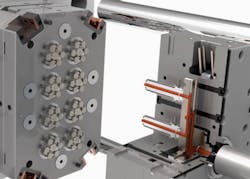A Hot Idea for High-Volume Diecasting
High-volume manufacturing operations typically are not the place to spot process innovations, but in the case of diecasting an idea has emerged that may counter that notion. Ferrofacta GmbH is calling attention to its effort to adapt a hot-runner technique associated with plastic injection molding to production of zinc diecastings, which are very often produced in very high volumes.
Zinc is often a commodity-grade material chosen to produce lightweight, heat- and wear-resistant parts like clamps, fittings, flanges, but it offers design value in terms of holding close tolerances and dimensional stability for different sizes and shapes. All these factors, plus recyclability, make zinc appealing to designers of automotive and electronics components and housings, too.
Conventionally, diecasting is done using a hot-chamber system: molten metal is drawn into a heated chamber or cylinder, and then forced pneumatically or hydraulically through a sprue into a die. For diecasting more complex parts, a sprue bushing may be used to direct molten metal through runners and gates into the die cavities.
The system that Ferrofacta has patented parallels the plastic injection molding process, serving molten metal through the runner without gating. It claims this “hot runner” system makes it possible to feed a single complex die from multiple injection points, or to serve metal to multiple dies. Reportedly this method reduces the amount of metal scrap and increases diecasting cycle times versus more conventional processes.
Another reported advantage is better quality cast parts – specifically, metal with less porosity because there is less air entrained in the runner system, and better surface conditions because molten zinc temperatures, and that factor also contributes to higher productivity because there are fewer finished parts rejected for quality issues.
Extending the logic a step further, injecting molten zinc into the mold establishes the potential for complex, thin-wall designs, which together with quality surfaces will promote production of higher-value diecastings. This detail is supported by the availability of newer, high-strength zinc alloys suitable for thinner, sturdier for housings or hardware, for example.
Among the potential, high-volume products suggested for zinc diecastings are electrical housings or covers, or laptop and phone cases, produced directly from a diecasting machine.
In overview, Ferrofacta argues that its hot runner system makes the diecasting process more adaptable to new production programs, with quicker set-ups and lower tooling costs. The technology behind hot-runner diecasting is part of the system design, so machine programming is straightforward too. This simplicity will also address the skilled-worker shortage that so many metalcasting operations face.
Finally, the developer also makes a case for the sustainability of its hot runner system. Increasing the throughput and productivity of zinc diecasting reduces the level of carbon emissions that might have resulted from recycling scrap metal.
